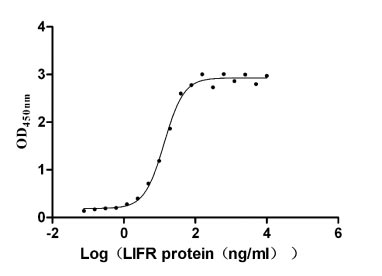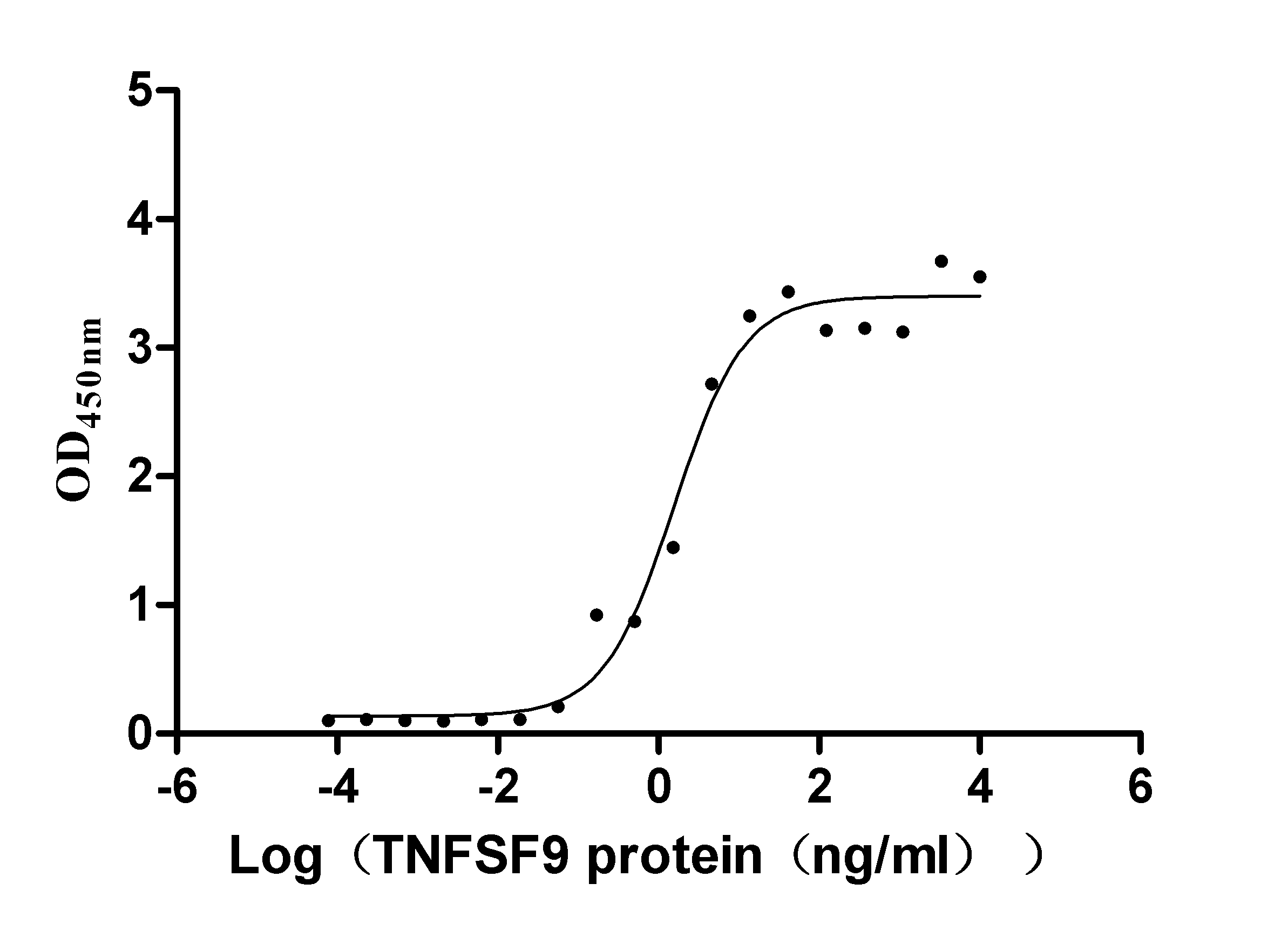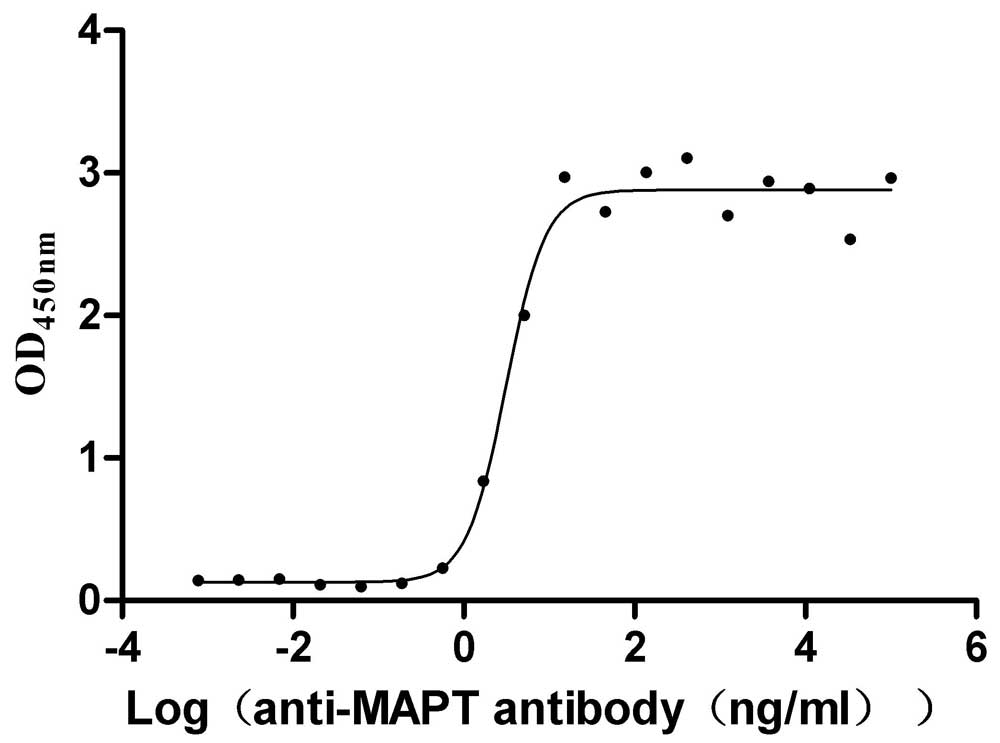Recombinant Mouse Monocyte differentiation antigen CD14 (Cd14)
-
货号:CSB-YP004879MO
-
规格:
-
来源:Yeast
-
其他:
-
货号:CSB-EP004879MO
-
规格:
-
来源:E.coli
-
其他:
-
货号:CSB-EP004879MO-B
-
规格:
-
来源:E.coli
-
共轭:Avi-tag Biotinylated
E. coli biotin ligase (BirA) is highly specific in covalently attaching biotin to the 15 amino acid AviTag peptide. This recombinant protein was biotinylated in vivo by AviTag-BirA technology, which method is BriA catalyzes amide linkage between the biotin and the specific lysine of the AviTag.
-
其他:
-
货号:CSB-BP004879MO
-
规格:
-
来源:Baculovirus
-
其他:
-
货号:CSB-MP004879MO
-
规格:
-
来源:Mammalian cell
-
其他:
产品详情
-
纯度:>85% (SDS-PAGE)
-
基因名:
-
Uniprot No.:
-
别名:Cd14Monocyte differentiation antigen CD14; Myeloid cell-specific leucine-rich glycoprotein; CD antigen CD14
-
种属:Mus musculus (Mouse)
-
蛋白长度:Full Length of Mature Protein
-
表达区域:16-336
-
氨基酸序列SPAPP EPCELDEESC SCNFSDPKPD WSSAFNCLGA ADVELYGGGR SLEYLLKRVD TEADLGQFTD IIKSLSLKRL TVRAARIPSR ILFGALRVLG ISGLQELTLE NLEVTGTAPP PLLEATGPDL NILNLRNVSW ATRDAWLAEL QQWLKPGLKV LSIAQAHSLN FSCEQVRVFP ALSTLDLSDN PELGERGLIS ALCPLKFPTL QVLALRNAGM ETPSGVCSAL AAARVQLQGL DLSHNSLRDA AGAPSCDWPS QLNSLNLSFT GLKQVPKGLP AKLSVLDLSY NRLDRNPSPD ELPQVGNLSL KGNPFLDSES HSEKFN
-
蛋白标签:Tag type will be determined during the manufacturing process.
The tag type will be determined during production process. If you have specified tag type, please tell us and we will develop the specified tag preferentially. -
产品提供形式:Lyophilized powder
Note: We will preferentially ship the format that we have in stock, however, if you have any special requirement for the format, please remark your requirement when placing the order, we will prepare according to your demand. -
复溶:We recommend that this vial be briefly centrifuged prior to opening to bring the contents to the bottom. Please reconstitute protein in deionized sterile water to a concentration of 0.1-1.0 mg/mL.We recommend to add 5-50% of glycerol (final concentration) and aliquot for long-term storage at -20℃/-80℃. Our default final concentration of glycerol is 50%. Customers could use it as reference.
-
储存条件:Store at -20°C/-80°C upon receipt, aliquoting is necessary for mutiple use. Avoid repeated freeze-thaw cycles.
-
保质期:The shelf life is related to many factors, storage state, buffer ingredients, storage temperature and the stability of the protein itself.
Generally, the shelf life of liquid form is 6 months at -20°C/-80°C. The shelf life of lyophilized form is 12 months at -20°C/-80°C. -
货期:Delivery time may differ from different purchasing way or location, please kindly consult your local distributors for specific delivery time.Note: All of our proteins are default shipped with normal blue ice packs, if you request to ship with dry ice, please communicate with us in advance and extra fees will be charged.
-
注意事项:Repeated freezing and thawing is not recommended. Store working aliquots at 4°C for up to one week.
-
Datasheet :Please contact us to get it.
靶点详情
-
功能:Coreceptor for bacterial lipopolysaccharide. In concert with LBP, binds to monomeric lipopolysaccharide and delivers it to the LY96/TLR4 complex, thereby mediating the innate immune response to bacterial lipopolysaccharide (LPS). Acts via MyD88, TIRAP and TRAF6, leading to NF-kappa-B activation, cytokine secretion and the inflammatory response. Acts as a coreceptor for TLR2:TLR6 heterodimer in response to diacylated lipopeptides and for TLR2:TLR1 heterodimer in response to triacylated lipopeptides, these clusters trigger signaling from the cell surface and subsequently are targeted to the Golgi in a lipid-raft dependent pathway. Acts as an accessory receptor for M.tuberculosis lipoproteins LprA, LprG and LpqH, in conjunction with coreceptors TLR2 and TLR1. The lipoproteins act as agonists to modulate antigen presenting cell functions in response to the pathogen. Binds electronegative LDL (LDL(-)) and mediates the cytokine release induced by LDL(-).
-
基因功能参考文献:
- Overall, CD14/TLR4 signalling seems to be critical for intestinal barrier function and for the crosstalk between B cells and the epithelium, underlining that CD14 serves as a protective modulator of intestinal homeostasis. PMID: 29335601
- Investigations on the variant of CD14 gene revealed negative association among ischemic stroke patients; however, a significant association was observed for hemorrhagic stroke following dominant and recessive genotypic model. PMID: 28963650
- this paper shows that CD14 gene silencing alters the microRNA expression profile of RAW264.7 cells stimulated by Brucella melitensis infection PMID: 28443393
- Data show that multiple phagocytes are capable of hyperactivation in response to oxPAPC, with CD14 antigen acting as the earliest regulator in this process, serving to capture and transport these lipids to promote inflammatory cell fate decisions. PMID: 29045901
- Data (including data from studies conducted in cells from knockout mice) suggest that signaling via Lpar1, Cd14, and Scara1 mediates uptake of oxidized LDL by macrophages leading to foam cell formation; lysophosphatidic acid (LPA) induces expression of Cd14 and Scara1 in macrophages. (Lpar1 = LPA receptor 1; Cd14 = monocyte differentiation antigen CD14; Scara1 = scavenger receptor class A type I) PMID: 28705936
- Stimulation of murine peritoneal macrophages with LPS induces biphasic accumulation of PI(4,5)P2 with peaks at 10 and 60-90 min that was abrogated when CD14 was removed from the cell surface. PMID: 27418354
- these results indicate that CD14 is a co-receptor of TLR4 in the S100A9-induced cytokine response. PMID: 27228163
- this study shows that lipid rafts may serve as sites in which LPS receptors (CD14) are sorted for endocytosis, rather than being platforms for the assembly of TLR4-centered signaling complexes PMID: 27908440
- These findings suggested that the degree of lung injury was reduced during the acute inflammatory reaction when NFkappaB was inhibited, and that the expression of sphingomyelin synthase 2 may affect the induction of the NFkappaB pathway by lipopolysaccharide through CD14. PMID: 27510408
- Results demonstrate remarkable sophistication of microglial CD14 in enabling, facilitating and moderating innate immune responses to infectious and non-infectious CNS threats of diverse kinds PMID: 26683584
- CD14-mediated lipid signaling induced epithelial apoptosis, whereas TLR4 antagonistically promoted cell survival and cancer development. PMID: 25633197
- fucosyllactose directly inhibits lipopolysaccharide-mediated inflammation during E. coli infection of intestinal epithelial cells through attenuation of CD14 induction. PMID: 25431457
- studies revealed a novel physical association between SP-R210S, CD14, and SR-A leading to an enhanced response to LPS, and found that SP-R210L and SP-R210S regulate internalization of CD14 via distinct macropinocytosis-like mechanisms PMID: 25965346
- Data indicate that Toll-like receptor 4 (TLR4) endocytosis and the TIR-domain-containing adapter-inducing IFN-beta (TRIF)-signaling pathway in macrophages during endotoxin tolerance in the absence of cluster of differentiation 14 (CD14). PMID: 26106158
- 27OHChol can prime monocytes/macrophages by up-regulation of CD14 such that LPS-mediated inflammatory reaction is accelerated, thereby contributing to aggravated development of atherosclerotic lesions. PMID: 25497142
- microglial HSPGs facilitate CD14-dependent TLR4 activation and that heparanase can modulate this mechanism PMID: 25869127
- Data show that guanine nucleotide-binding protein G(i) subunit alpha-1 and alpha-3 (Galphai1/3) can interact with CD14 antigen/Grb2-associated binding protein Gab1, which modulates macrophage polarization in vitro and in vivo. PMID: 25825741
- In acute lung injury, lipopolysaccharide induced alveolar macrophage necrosis via CD14 and the P2X7 receptor leading to interleukin-1alpha release. PMID: 25862090
- We demonstrated that TLR2, TLR4 and CD14 receptors sense Tityus serrulatus venom (TsV) and its major component, toxin 1 (Ts1), to mediate cytokine and lipid mediator production. PMID: 24516606
- Gene expression of the anti-inflammatory cytokine IL-13 in prion-infected CD14(-/-) mice was temporarily upregulated at 75dpi, whereas IL-13 gene expression was not upregulated in prion-infected WT mice. PMID: 25450368
- Data show that ingestion of sCD14 resulted in blood sCD14 levels up. PMID: 24703105
- Mouse astrocytes expressed CD14 diffently than human expression of CD14 in astrocytes. PMID: 24659539
- CD14 knockdown significantly changed the expression of 199a-3p, miR-199a-5p, and miR-21-5p in RAW264.7 cells PMID: 24062059
- Mechanistically, mDia1 deficiency led to a downregulation of membrane-associated genes and a specific upregulation of CD14 messenger RNA in granulocytes, but not in other lineages. PMID: 24891322
- Collectively, these data identify a previously unrecognized role for CD14 in regulating macrophage plasticity and CD4(+) T cell biasing during Schistosoma mansoni infection. PMID: 24866794
- specific blockade of CD14 and C5 might represent a promising new therapeutic strategy for treatment of polymicrobial sepsis. PMID: 24790148
- CD14 together with SR participates in the binding of high doses of sLPS PMID: 24489448
- CD14 is actively involved in hepatic I/R injury. PMID: 23656919
- VB-201 may counter inflammation where TLR-2 and/or CD14 complicity is essential, and is therefore beneficial for the treatment of atherosclerosis. PMID: 24116867
- CD14 plays a role in the disease progression by suppressing anti-inflammatory responses in the brain in the early stage of infection. PMID: 24089559
- Signaling of HMGB1 through toll-like receptor 4 in macrophages requires CD14. PMID: 23508573
- Findings link CD14 innate immune signaling via a novel IL-6 amplification loop to adventitial macrophage precursor recruitment in the pathogenesis of abdominal aortic aneurysm. PMID: 23537804
- Signaling pathway iNOS->CD14->NF-kappaB mediated inflammatory response during stroke. PMID: 23416151
- Lgr4/Gpr48 negatively regulates TLR2/4-associated pattern recognition and innate immunity by targeting CD14 expression. PMID: 23589304
- CD14 protein has a role in immune recognition of Salmonella curli fibers PMID: 23548899
- These studies show for the first time that lipopolysaccharide causes an increase in intestinal permeability via an intracellular mechanism involving TLR-4-dependent up-regulation of CD14 membrane expression. PMID: 23201091
- Stimulation of a local CD14-independent chemokine induction pathway without triggering a systemic CD14-dependent chemokine pathway can protect against severe Escherichia coli infections. PMID: 22591691
- PGES-1 activation, PGE2 production, and edema formation in response to lipopolysaccharide challenge required CD14 and NFAT. PMID: 22466648
- murine Cd14 SNPs regulate the length of Cd14 mRNA and CD14 protein translation efficiency, and consequently the basal level of soluble CD14 (sCD14) and type I IFN production by murine macrophages PMID: 22445606
- CD14-ko mice, fed either normal or high-fat diets, displayed significant glucose intolerance compared to wild type controls. PMID: 22253759
- FSTL1 induced interleukin 6 or interleukin 8 production from target cells in a CD14- and TLR4-dependent manner. PMID: 22265692
- Lactate dehydrogenase-elevating virus infection induces a decrease in CD14 expression. PMID: 21940410
- Phosphatidyl-myo-inositol mannosides- PIM(1) and PIM(2) analogues inhibited LPS-induced TNF release by a CD14-dependent pathway, while IL-12 p40 inhibition was CD14-independent. PMID: 21949737
- These data establish that upon microbial detection, an upstream Pattern Recognition Receptor, CD14 controls the trafficking and signaling functions of a downstream Pattern Recognition Receptor, TLR4. PMID: 22078883
- CD14 modulates adipose tissue inflammatory activity and insulin resistance. PMID: 21700881
- this study shows that Cd14-promoter polymorphisms affect CD14 expression and confirms the protective effect of CD14 against experimental inflammatory bowel disease. PMID: 19637338
- S-LPS and R-LPS at low dose induced acute lung inflammation in a CD14-dependent manner, while the inflammatory response triggered by high dose S-LPS or R-LPS was diminished by CD14. PMID: 20419140
- CD14 deficiency leads to decreased activation of matrix metalloproteinase 9, reduced degradation of collagen, and diminished recruitment of neutrophils. PMID: 21281805
- In a mouse model of endotoxemia, neutrophil recruitment within the liver is completely independent of CD14 regardless of whether it is expressed on cells of hematopoietic or nonhematopoietic origin or in serum as soluble CD14. PMID: 21217012
- The significant increase in plasma endotoxin and soluble CD14 levels during biliary atresia implies a possible involvement of endotoxin stimulated CD14 production. PMID: 21172039
显示更多
收起更多
-
亚细胞定位:Cell membrane; Lipid-anchor, GPI-anchor. Secreted. Membrane raft. Golgi apparatus.
-
组织特异性:Detected on peritoneal macrophages (at protein level). Cell surface expression detected in lung alveolar macrophages, dendritic macrophages and lung macrophages (at protein level).
-
数据库链接:
KEGG: mmu:12475
STRING: 10090.ENSMUSP00000056669
UniGene: Mm.3460
Most popular with customers
-
Recombinant Human Leukemia inhibitory factor receptor (LIFR), partial (Active)
Express system: Mammalian cell
Species: Homo sapiens (Human)
-
Recombinant Human Tumor necrosis factor receptor superfamily member 9 (TNFRSF9), partial (Active)
Express system: Mammalian cell
Species: Homo sapiens (Human)
-
Recombinant Human Prolactin receptor (PRLR), partial (Active)
Express system: Mammalian cell
Species: Homo sapiens (Human)
-
Recombinant Macaca mulatta Microtubule-associated protein tau (MAPT) (Active)
Express system: Mammalian cell
Species: Macaca mulatta (Rhesus macaque)
-
Recombinant Dog Angiopoietin-2 (ANGPT2) (Active)
Express system: Mammalian cell
Species: Canis lupus familiaris (Dog) (Canis familiaris)
-
Recombinant Human Mucin-17 (MUC17), partial (Active)
Express system: Mammalian cell
Species: Homo sapiens (Human)
-
Recombinant Mouse Complement component C1q receptor (Cd93), partial (Active)
Express system: Mammalian cell
Species: Mus musculus (Mouse)
-
Recombinant Human C-C chemokine receptor type 8 (CCR8)-VLPs (Active)
Express system: Mammalian cell
Species: Homo sapiens (Human)




















